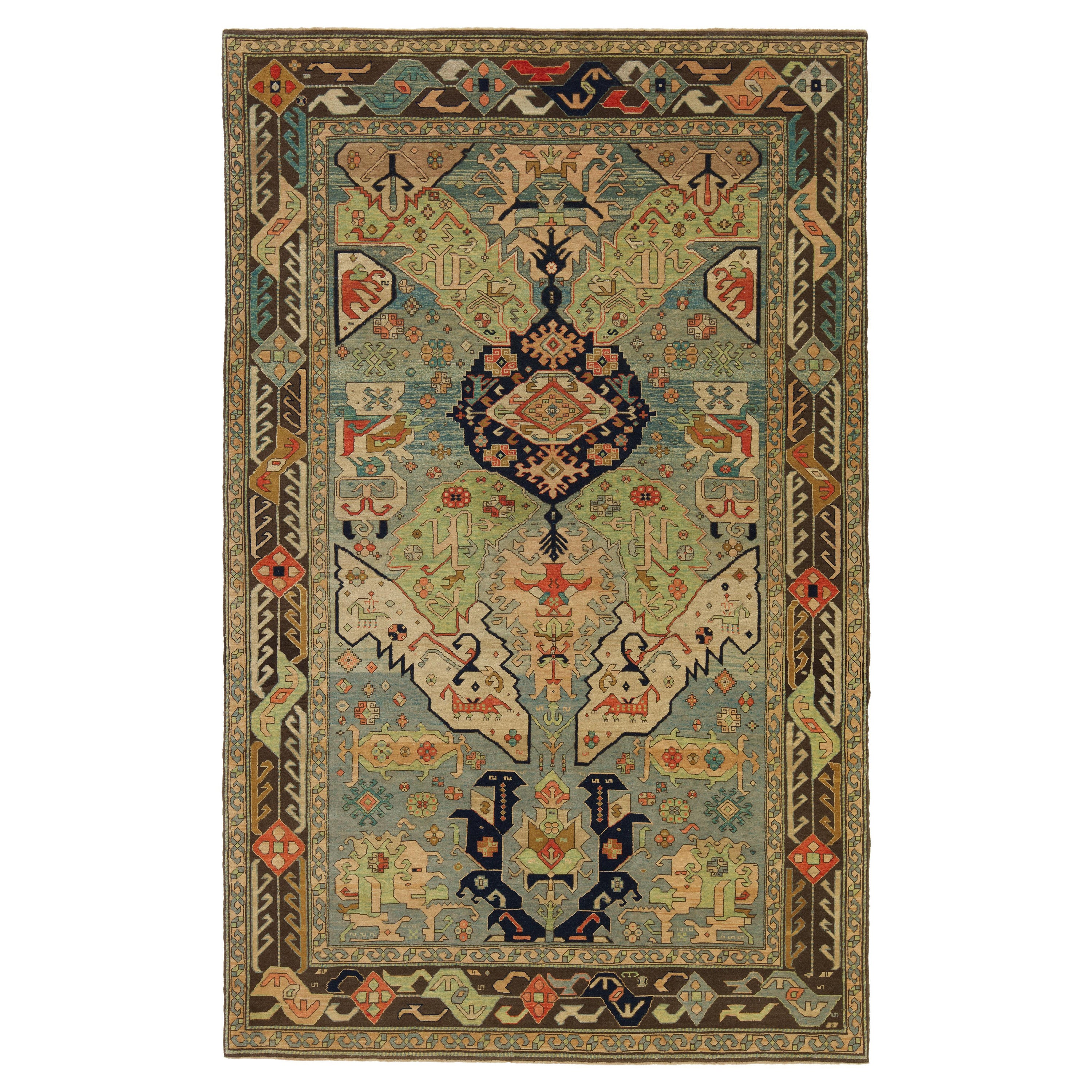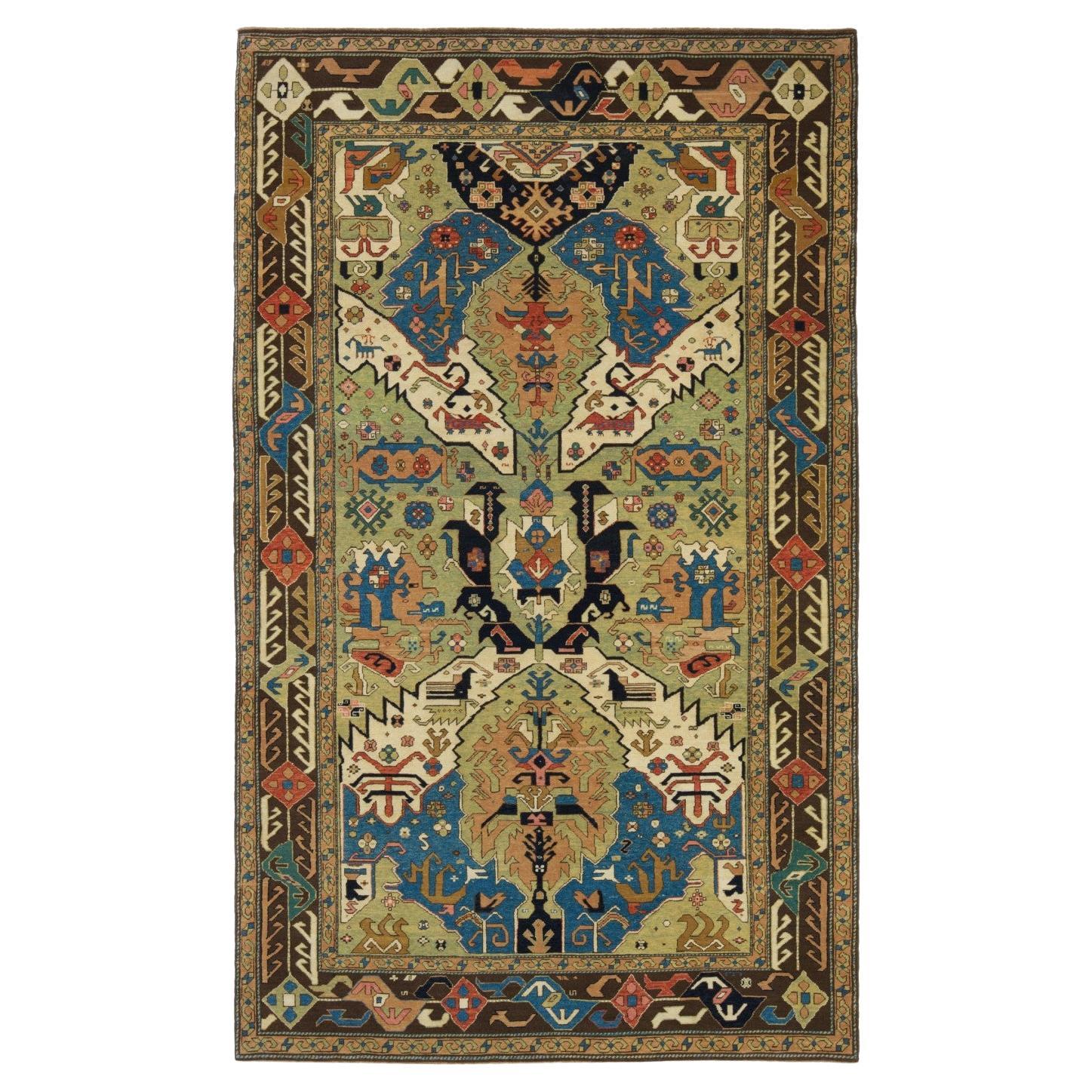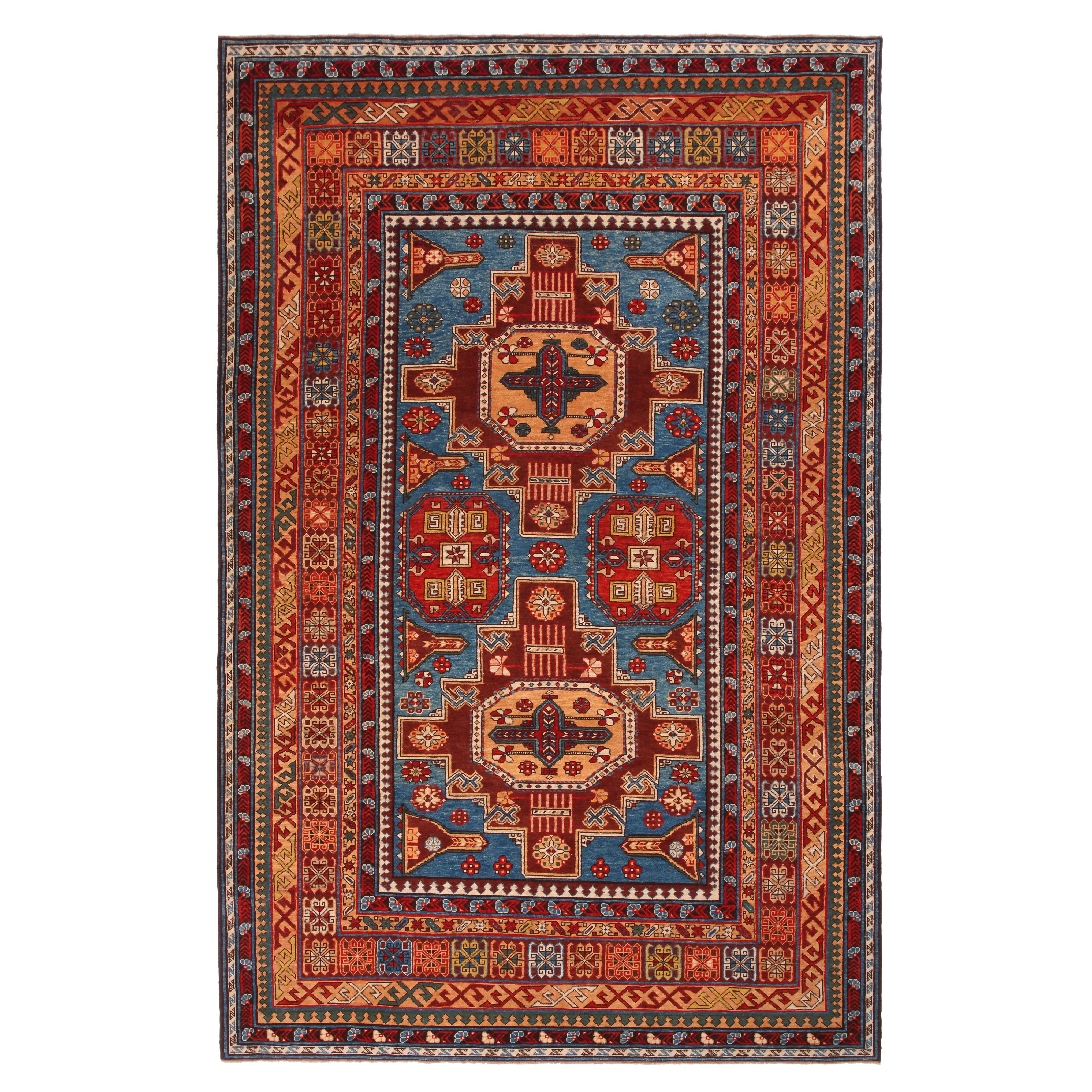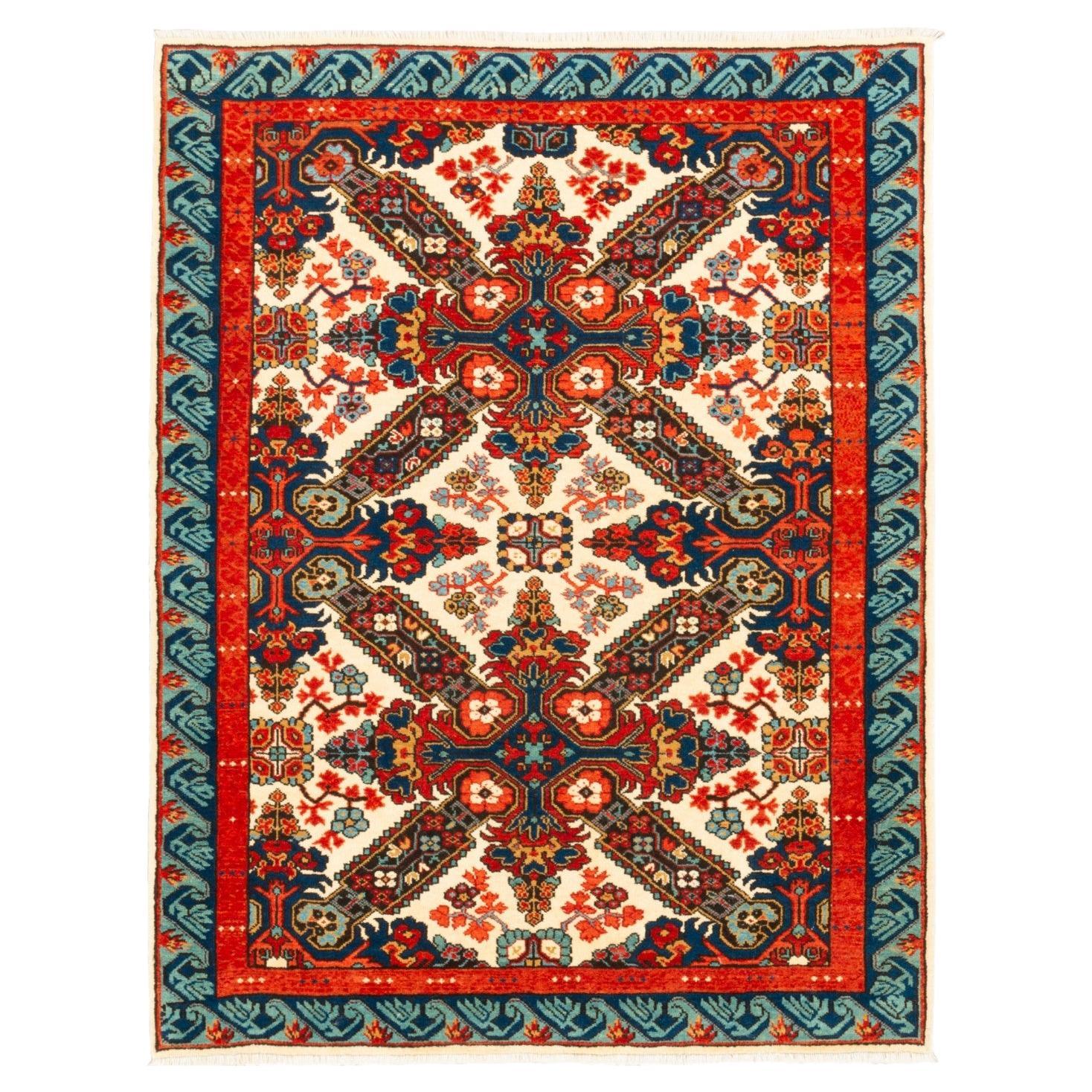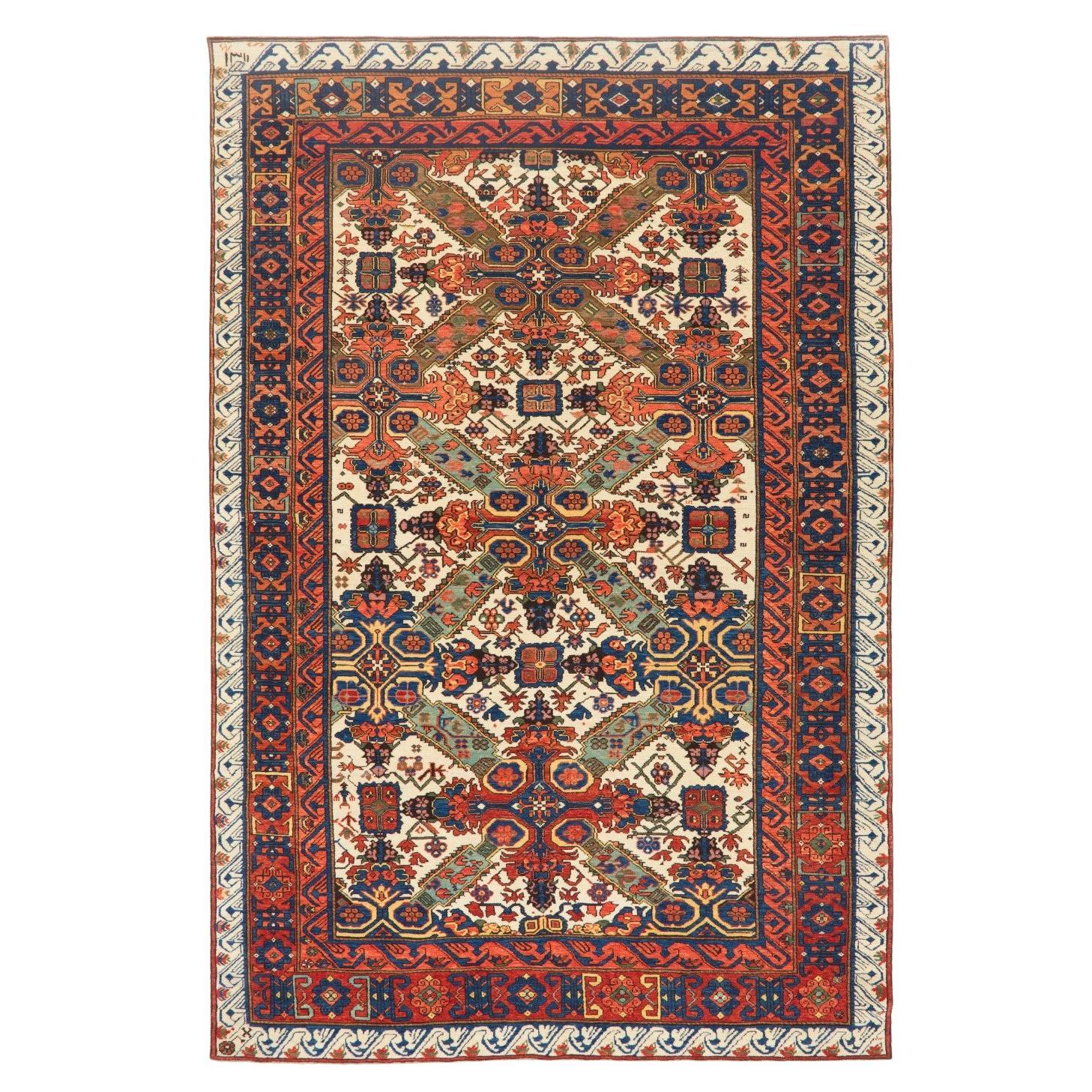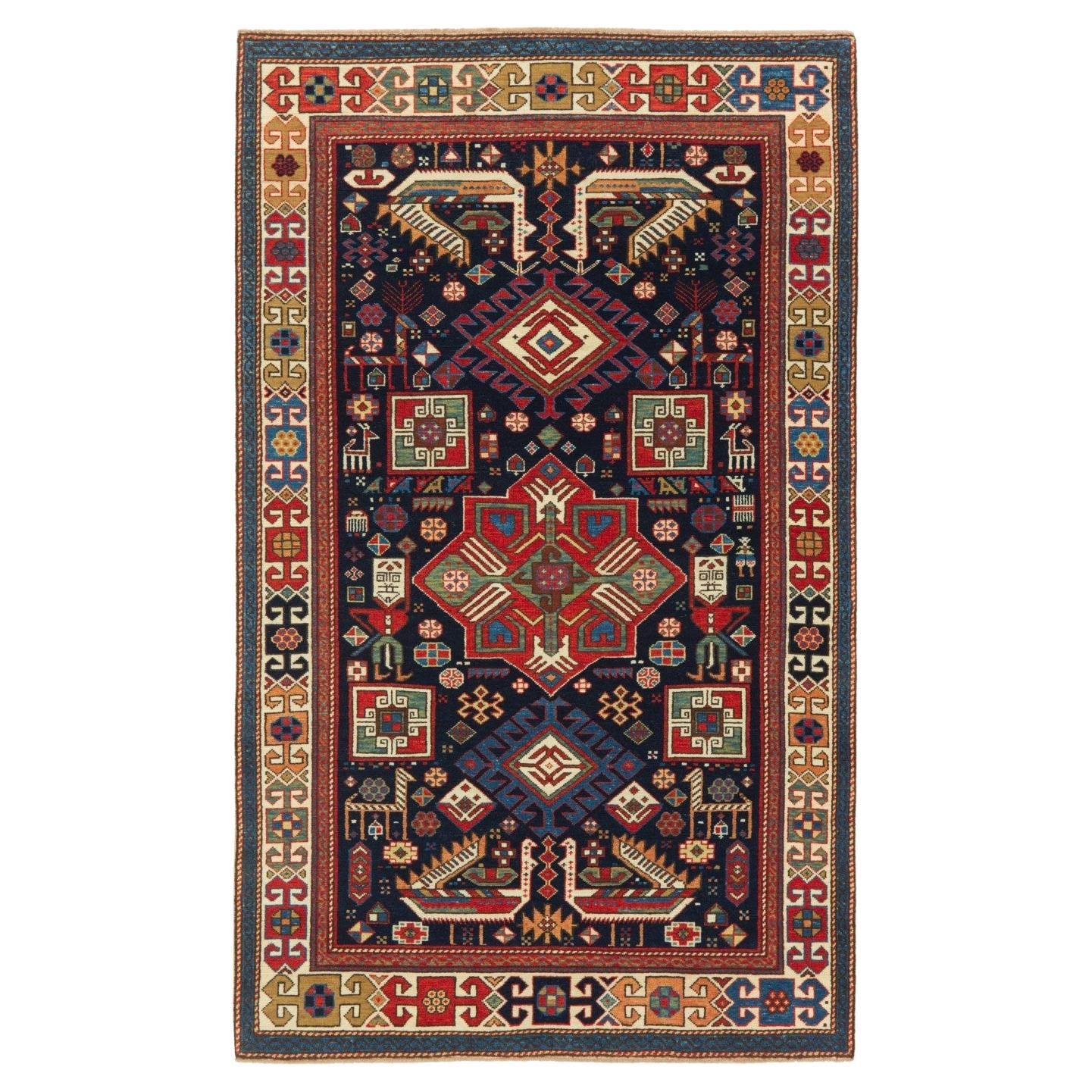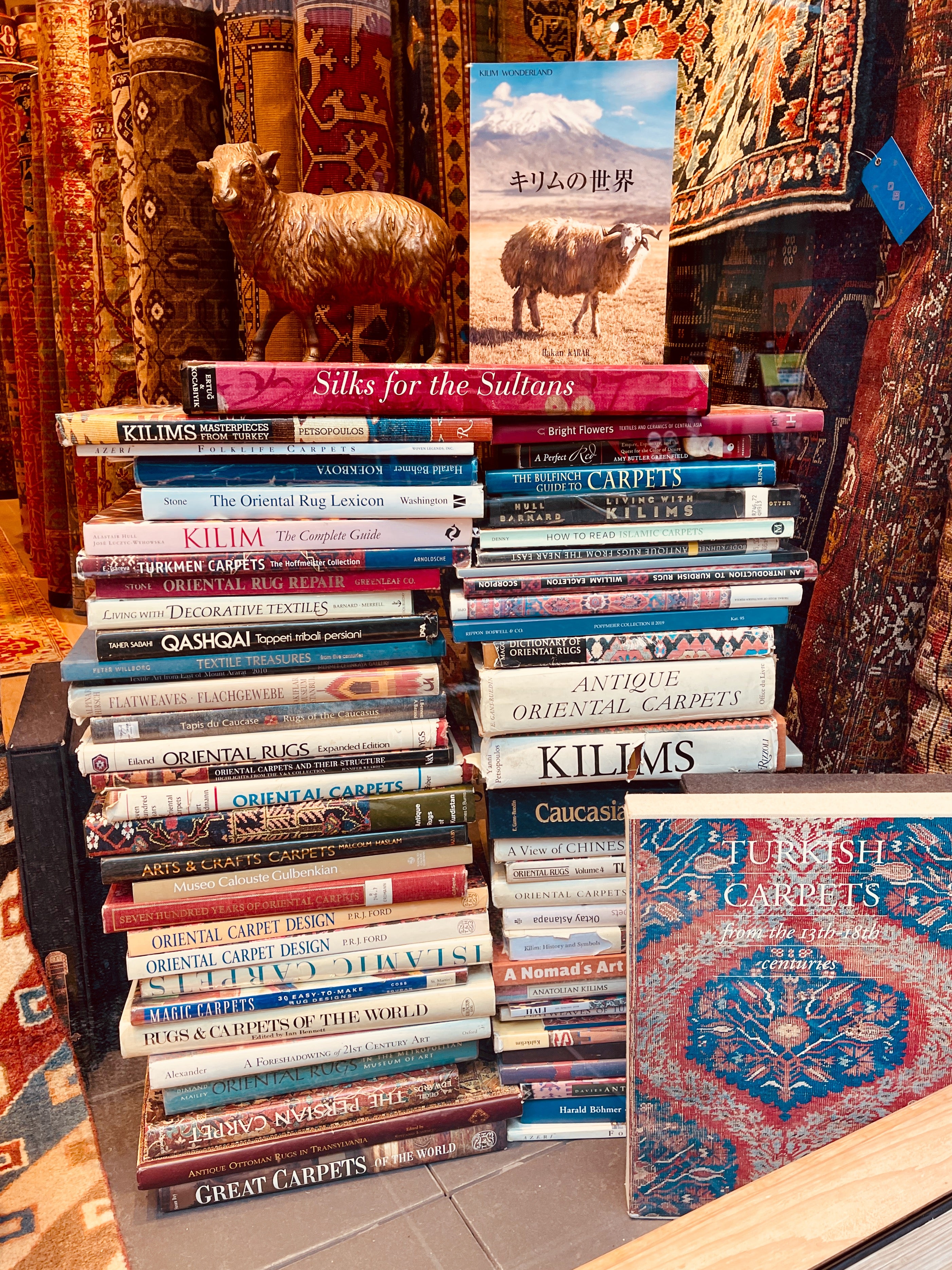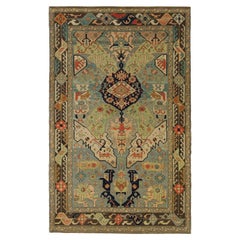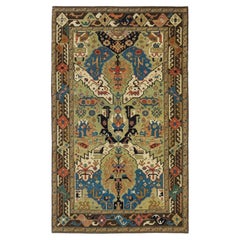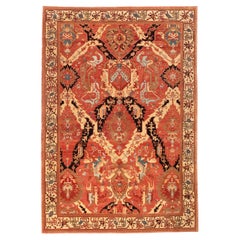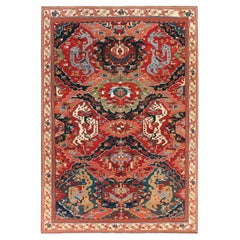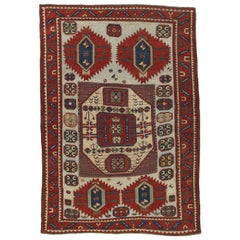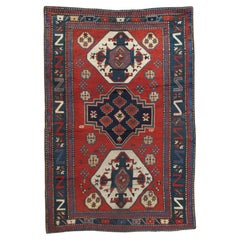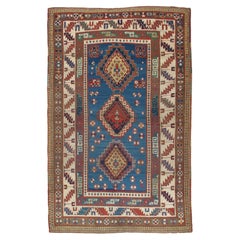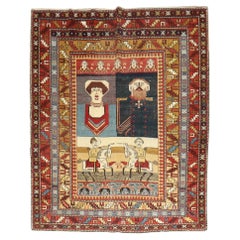Items Similar to Ararat Rugs Dragon Rug, Antique Caucasus Museum Revival Carpet, Natural Dyed
Want more images or videos?
Request additional images or videos from the seller
1 of 9
Ararat Rugs Dragon Rug, Antique Caucasus Museum Revival Carpet, Natural Dyed
About the Item
The source of the rug comes from the book Caucasian Carpets, E. Gans-Reudin, Thames and Hudson, Switzerland 1986, pg.37. This luxurious and varied work is known as the Cassirer dragon rug' from the name of its previous owner. It is examined in great detail in May U. Beattie's The Thyssen-Bornemisza Collection of Oriental Rugs. The carpet is divided into compartments by a fanciful lattice enclosing elongated or squat lozenges that are linked by palmettes, rosettes, and floral arrangements. The dragons can be distinguished to the right and left of the central row of lozenges, bedecked in blue, ivory, and red. Some appear also on the blue-black bands that define the lozenges. Flowers too are much in evidence; on stems of exquisite delicacy, they surround the dragons or are inscribed within their scrolls. The deeply notched border is highly original; it is a type rarely repeated by the weavers of succeeding centuries. From a light blue hexagonal flower, set on the ivory path of the main border, two stems escape bearing other flowers in red, black, and yellow. Two yellow guard bands flank the border; each contains a zigzag pattern undulating between red flower buds. The design of this rug is interpreted and the most appropriate colors to match the original are used for this rug.
Color summary: 6 colors in total;
Dark Brown 316 (No Dye - Sheep’s Color)
Imperial Red 415 (Madder Root)
Natural Wool Color 320 (Specially Washed)
Sunray Color 405 (Henna)
Green Blue 344 (Spurge - Madder Root - Indigo)
Pine Tree 420 (Henna - Indigo)
Group: Islamic Rugs Family
Area: Mamluk
Material of Pile: Natural Dyed Hand-spun Wool
Material Warp / Weft: Wool on Wool
Structure: Symmetrical knot on depressed warp inclining to the right
Knots Density: 39x39
Production Place: Southeastern Anatolia – Adiyaman
Pattern Code: MK 1086 225X331 AR0273
Weight: 20.60kg
Location: Tokyo
Dimensions:
10 ft 8 in x 7 ft 3 in ( 327cm x 222cm )
- Creator:Ararat Rugs (Manufacturer)
- Dimensions:Width: 87.41 in (222 cm)Length: 128.75 in (327 cm)
- Style:Revival (In the Style Of)
- Materials and Techniques:
- Place of Origin:
- Period:
- Date of Manufacture:2023
- Production Type:New & Custom(One of a Kind)
- Estimated Production Time:Available Now
- Condition:
- Seller Location:Tokyo, JP
- Reference Number:1stDibs: LU8206238891792
ARARAT RUGS
We know and believe that the geography we come from, our past, and our lifestyle are the most important bond between us to carry the oriental carpet art and culture to the next generations along with our core values in our ongoing growth journey.
We are aware that the way to achieve this goal and carry this priceless art and culture to the future depends on a lot of work with all our people every day while adhering to our core values.
For us, art is meaningful in the sense that it brings together various cultures around the world. It is an honor for us that oriental carpet art and culture have been instrumental in this for centuries and that we are a part of this business.
We are tirelessly keeping an eye on auction house information around the world about carpets. New York's Metropolitan, London's Victoria & Albert Museums, and other famous art museums, as well as small specialized museums that house private collections, and books about oriental carpets to collect information on outstanding carpet designs and patterns from around the world. It's our Self-improving and Self-developing culture.
As Turkish Culture of Hospitality, the Kurdish Culture of Generosity, and as Japanese Culture of Business Punctuality; are the most important values that this multicultural background has taught and bequeathed to us. It is essential and valuable for us that you feel this feeling not only by looking at our oriental carpets but from the moment you contact us.
About the Seller
5.0
Platinum Seller
Premium sellers with a 4.7+ rating and 24-hour response times
Established in 1970
1stDibs seller since 2023
51 sales on 1stDibs
Typical response time: 1 hour
- ShippingRetrieving quote...Shipping from: Tokyo, Japan
- Return Policy
Authenticity Guarantee
In the unlikely event there’s an issue with an item’s authenticity, contact us within 1 year for a full refund. DetailsMoney-Back Guarantee
If your item is not as described, is damaged in transit, or does not arrive, contact us within 7 days for a full refund. Details24-Hour Cancellation
You have a 24-hour grace period in which to reconsider your purchase, with no questions asked.Vetted Professional Sellers
Our world-class sellers must adhere to strict standards for service and quality, maintaining the integrity of our listings.Price-Match Guarantee
If you find that a seller listed the same item for a lower price elsewhere, we’ll match it.Trusted Global Delivery
Our best-in-class carrier network provides specialized shipping options worldwide, including custom delivery.More From This Seller
View AllArarat Rugs Dragon Rug, Antique Caucasus Museum Revival Carpet, Natural Dyed
By Ararat Rugs
Located in Tokyo, JP
There has long been a fascination with the symbolism of the dragon and its depiction in carpet weavings. The design of ‘Dragon’ carpets consists of a field pattern composed of different colored overlaid lattices formed of pointed, serrated leaves creating intersecting lozenges, which alternately contain palmettes and are flanked by confronting stylized dragons, birds, or animal figures. The most archaic of the ‘Dragon’ carpets include dragon motifs with birds and running animals relatively naturalistically drawn, which stand either alone or in confronting pairs facing a tree. The Graf carpet, originally found in a Damascene mosque, now in the Islamiches Museum, Berlin, is considered to be the oldest example of this type, see Serare Yetkin, Early Caucasian Carpets in Turkey, Vol. II, London, 1978, p.8, fig.118. Yetkin defines four types of ‘Dragon’ carpet: ‘Archaic’, ‘Four-Dragon’, ‘Dragon-and-Phoenix’ and as a further combined development of the latter, the ‘Two-Dragon’ style, of which the present carpet falls into the ‘Dragon-and-Phoenix group along with other examples, some of which include two fragments, one in the Museum fur Kunst und Gerwerbe, Hamburg; another in the Christian Museum, Esztergom, Hungary, a complete carpet in the Kier collection; an incomplete example in the Textile Museum, Washington, D.C; the ‘Cassirer’ Dragon carpet in the Thyssen-Bornemisza collection, Lugano; the Ali Pasa Mosque carpet in Tokat, and a further example in the Vakiflar Hali Museum, Istanbul (S. Yetkin, op. cit. pp.16-20). It has been suggested that the earliest examples of the Caucasian ‘Dragon’ carpets...
Category
21st Century and Contemporary Caucasian Revival Caucasian Rugs
Materials
Wool, Organic Material, Natural Fiber
Ararat Rugs Dragon Rug, Antique Caucasus Museum Revival Carpet, Natural Dyed
By Ararat Rugs
Located in Tokyo, JP
There has long been a fascination with the symbolism of the dragon and its depiction in carpet weavings. The design of ‘Dragon’ carpets consists of a field pattern composed of differ...
Category
21st Century and Contemporary Caucasian Oushak Caucasian Rugs
Materials
Wool, Natural Fiber, Organic Material
Ararat Rugs Dragon Rug, Antique Caucasus Museum Revival Carpet, Natural Dyed
By Ararat Rugs
Located in Tokyo, JP
The source of the rug comes from the book Caucasian Carpets, E. Gans-Reudin, Thames and Hudson, Switzerland 1986, pg.37. This luxurious and varied work is known as the Cassirer drago...
Category
21st Century and Contemporary Turkish Revival Caucasian Rugs
Materials
Wool, Organic Material, Natural Fiber
Ararat Rugs Dragon Rug, Antique Caucasus Museum Revival Carpet, Natural Dyed
By Ararat Rugs
Located in Tokyo, JP
The source of the rug comes from the book Orient Star – A Carpet Collection, E. Heinrich Kirchheim, Hali Publications Ltd, 1993 nr.57. There has long been a fascination with the symbolism of the dragon and its depiction in carpet weavings. The design of ‘Dragon’ carpets consists of a field pattern composed of different colored overlaid lattices formed of pointed, serrated leaves creating intersecting lozenges, which alternately contain palmettes and are flanked by confronting stylized dragons, birds, or animal figures. The most archaic of the ‘Dragon’ carpets include dragon motifs with birds and running animals are relatively naturalistically drawn, which stand either alone or in confronting pairs facing a tree. The Graf carpet, originally found in a Damascene mosque, now in the Islamiches Museum, Berlin, is considered to be the oldest example of this type, see Serare Yetkin, Early Caucasian Carpets in Turkey, Vol. II, London, 1978, p.8, fig.118. Yetkin defines four types of ‘Dragon’ carpet: ‘Archaic’, ‘Four-Dragon’, ‘Dragon-and-Phoenix’ and as a further combined development of the latter, the ‘Two-Dragon’ style, of which the present carpet falls into the ‘Dragon-and-Phoenix group along with other examples, some of which include two fragments, one in the Museum fur Kunst und Gerwerbe, Hamburg; another in the Christian Museum, Esztergom, Hungary, a complete carpet in the Kier collection; an incomplete example in the Textile Museum, Washington, D.C; the ‘Cassirer’ Dragon carpet in the Thyssen-Bornemisza collection, Lugano; the Ali Pasa Mosque carpet in Tokat, and a further example in the Vakiflar Hali Museum, Istanbul (S. Yetkin, op. cit. pp.16-20). It has been suggested that the earliest examples of the Caucasian ‘Dragon’ carpets...
Category
21st Century and Contemporary Turkish Revival Caucasian Rugs
Materials
Wool, Organic Material, Natural Fiber
Ararat Rugs Konagkend Kuba Rug, Antique Caucasian Revival Carpet, Natural Dyed
By Ararat Rugs
Located in Tokyo, JP
The source of the rug comes from the book Oriental Rugs Volume 1 Caucasian, Ian Bennett, Oriental Textile Press, Aberdeen 1993, nr.332. This is a sp...
Category
21st Century and Contemporary Turkish Revival Caucasian Rugs
Materials
Wool, Organic Material, Natural Fiber
Ararat Rugs Seichur Kuba Rug Caucasian Antique Kazak Revival Carpet Natural Dyed
By Ararat Rugs
Located in Tokyo, JP
The source of the rug comes from the book Tapis du Caucase - Rugs of the Caucasus, Ian Bennett & Aziz Bassoul, The Nicholas Sursock Museum, Beirut, Lebanon 2003, nr.90 and Oriental R...
Category
21st Century and Contemporary Turkish Revival Caucasian Rugs
Materials
Wool, Natural Fiber, Organic Material
You May Also Like
Antique Karachov Kazak Carpet, Handmade Wool, Pale Blue, Rust, Ivory, Geometric
Located in Port Washington, NY
Karachov Kazak: A quite famous and seldom-found design type, usually attributed to the Armenian weavers of the high Caucasus Mountains. The best of the ...
Category
Antique Late 19th Century Russian Kazak Caucasian Rugs
Materials
Wool
$12,000 Sale Price
20% Off
Free Shipping
Antique Kazak Carpet, Handmade Wool, Rust, Ivory, Navy, Light Blue and Geometric
Located in Port Washington, NY
The Rust field scattered with minor stylized flower heads, hooked panels and minute cross-motifs around a column of ivory octagonal panels containing radiating flower heads and minut...
Category
Antique Late 19th Century Russian Kazak Caucasian Rugs
Materials
Wool
$11,999 Sale Price
25% Off
Free Shipping
Antique Kazak Carpet, Handmade Wool, Rust, Ivory, Navy, Light Blue and Gold
Located in Port Washington, NY
The Rust field scattered with minor stylized flower heads, hooked panels and minute cross-motifs around a column of ivory octagonal panels containing radiating flower heads and minut...
Category
Antique Late 19th Century Russian Kazak Caucasian Rugs
Materials
Wool
$11,999 Sale Price
20% Off
Free Shipping
19th Century Antique Shirvan Caucasian Pictorial Rug
Located in New York, NY
AN intermediate square size antique Caucasian shirvan pictorial rug
circa 1875. Measures: 4'1" x 4'9''.
Category
Antique 19th Century Russian Campaign Caucasian Rugs
Materials
Wool
Quirky Folk Art Tribal Camel Medallion Caucasian Rug
Located in New York, NY
A geometric tribal looking Caucasian rug from the second quarter of the 20th century with saffron ground, accents in light blue and a goldenrod border. The central medallion has a ca...
Category
Mid-20th Century Caucasian Kazak Caucasian Rugs
Materials
Wool
Vintage Caucasian Floral Qarabagh Rug in the St. Petersburg Style
Located in Milan, IT
The floral ornamentation typical of French and English carpets of the 18th-19th century has influenced specific oriental carpet families. In the Caucasus this style became extremely ...
Category
Vintage 1930s Russian Bessarabian Caucasian Rugs
Materials
Wool
Recently Viewed
View AllMore Ways To Browse
Swiss Guard
Hudson Dragon
Fabien Baron
Falcon Chrome Chair
Famille Rose Mandarin
Famille Rose Tureen
Fan Back Windsor Chair
Fantoni Firenze
Farmhouse Ash Table
Farstrup Mobler
Faux Bamboo Tea Table
Faux Bois Arm Chair
Fd Coffee Table
Federal Two Drawer Stand
Fenton Glass White
Finn Juhl Chair 136
Finn Juhl Chair 46
Fleur De Lis Tapestry
